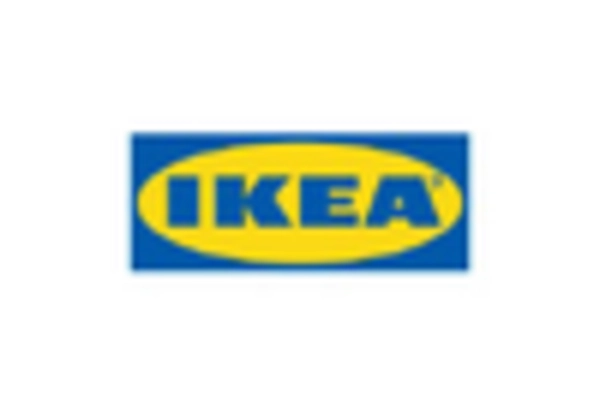-
EXECUTIVE SUMMARY
-
MARKET INTRODUCTION
-
Definition
-
Scope of the Study
- Research Objective
- Assumptions
- Limitations
-
RESEARCH METHODOLOGY
-
Overview
-
Data Mining
-
Secondary Research
-
Primary Research
- Primary Interviews and Information Gathering Process
- Breakdown of Primary Respondents
-
Forecasting Model
-
Market Size Estimation
- Bottom-Up Approach
- Top-Down Approach
-
Data Triangulation
-
Validation
-
MARKET DYNAMICS
-
Overview
-
Drivers
-
Restraints
-
Opportunities
-
MARKET FACTOR ANALYSIS
-
Value Chain Analysis
-
Porter’s Five Forces Analysis
- Bargaining Power of Suppliers
- Bargaining Power of Buyers
- Threat of New Entrants
- Threat of Substitutes
- Intensity of Rivalry
-
COVID-19 Impact Analysis
- Market Impact Analysis
- Regional Impact
- Opportunity and Threat Analysis
-
GLOBAL WALL ART MARKET, BY SALES CHANNEL
-
Overview
-
Dealers
-
Auction Houses
-
GLOBAL WALL ART MARKET, BY MATERIAL
-
Overview
-
Canvas
-
Paper
-
Others
-
GLOBAL WALL ART MARKET, BY TYPE
-
Overview
-
Fine
-
Abstract
-
Modern
-
Others
-
GLOBAL WALL ART MARKET, BY REGION
-
Overview
-
North America
- US
- Canada
-
Europe
- Germany
- France
- UK
- Italy
- Spain
- Rest of Europe
-
Asia-Pacific
- China
- India
- Japan
- South Korea
- Australia
- Rest of Asia-Pacific
-
Rest of the World
- Middle East
- Africa
- Latin America
-
COMPETITIVE LANDSCAPE
-
Overview
-
Competitive Analysis
-
Market Share Analysis
-
Major Growth Strategy in the Global Wall Art Market,
-
Competitive Benchmarking
-
Leading Players in Terms of Number of Developments in the Global Wall Art Market,
-
Key developments and Growth Strategies
- New Product Launch/Service Deployment
- Merger & Acquisitions
- Joint Ventures
-
Major Players Financial Matrix
- Sales & Operating Income, 2022
- Major Players R&D Expenditure. 2022
-
COMPANY PROFILES
-
Saatchi Art (U.S.)
- Company Overview
- Financial Overview
- Products Offered
- Key Developments
- SWOT Analysis
- Key Strategies
-
Artfinder (U.K.).
- Company Overview
- Financial Overview
- Products Offered
- Key Developments
- SWOT Analysis
- Key Strategies
-
Minted LLC. (U.S.)
- Company Overview
- Financial Overview
- Products Offered
- Key Developments
- SWOT Analysis
- Key Strategies
-
Artspace LLC (U.S.)
- Company Overview
- Financial Overview
- Products Offered
- Key Developments
- SWOT Analysis
- Key Strategies
-
Artsy (U.S.)
- Company Overview
- Financial Overview
- Products Offered
- Key Developments
- SWOT Analysis
- Key Strategies
-
Art.com (U.S.)
- Company Overview
- Financial Overview
- Products Offered
- Key Developments
- SWOT Analysis
- Key Strategies
-
Zatista LLC (U.S.)
- Company Overview
- Financial Overview
- Products Offered
- Key Developments
- SWOT Analysis
- Key Strategies
-
The Tellenge Store (India)
- Company Overview
- Financial Overview
- Products Offered
- Key Developments
- SWOT Analysis
- Key Strategies
-
ARTISERA (INDIA)
- Company Overview
- Financial Overview
- Products Offered
- Key Developments
- SWOT Analysis
- Key Strategies
-
Seven Wall Art Corporation (U.S.)
- Company Overview
- Financial Overview
- Products Offered
- Key Developments
- SWOT Analysis
- Key Strategies
-
APPENDIX
-
References
-
Related Reports
-
-
LIST OF TABLES
-
GLOBAL WALL ART MARKET, SYNOPSIS, 2018-2032
-
GLOBAL WALL ART MARKET, ESTIMATES & FORECAST, 2018-2032 (USD BILLION)
-
GLOBAL WALL ART MARKET, BY SALES CHANNEL, 2018-2032 (USD BILLION)
-
GLOBAL WALL ART MARKET, BY MATERIAL, 2018-2032 (USD BILLION)
-
GLOBAL WALL ART MARKET, BY TYPE, 2018-2032 (USD BILLION)
-
NORTH AMERICA: WALL ART MARKET, BY SALES CHANNEL, 2018-2032 (USD BILLION)
-
NORTH AMERICA: WALL ART MARKET, BY MATERIAL, 2018-2032 (USD BILLION)
-
NORTH AMERICA: WALL ART MARKET, BY TYPE, 2018-2032 (USD BILLION)
-
US: WALL ART MARKET, BY SALES CHANNEL, 2018-2032 (USD BILLION)
-
US: WALL ART MARKET, BY MATERIAL, 2018-2032 (USD BILLION)
-
US: WALL ART MARKET, BY TYPE, 2018-2032 (USD BILLION)
-
CANADA: WALL ART MARKET, BY SALES CHANNEL, 2018-2032 (USD BILLION)
-
CANADA: WALL ART MARKET, BY MATERIAL, 2018-2032 (USD BILLION)
-
CANADA: WALL ART MARKET, BY TYPE, 2018-2032 (USD BILLION)
-
EUROPE: WALL ART MARKET, BY SALES CHANNEL, 2018-2032 (USD BILLION)
-
EUROPE: WALL ART MARKET, BY MATERIAL, 2018-2032 (USD BILLION)
-
EUROPE: WALL ART MARKET, BY TYPE, 2018-2032 (USD BILLION)
-
GERMANY: WALL ART MARKET, BY SALES CHANNEL, 2018-2032 (USD BILLION)
-
GERMANY: WALL ART MARKET, BY MATERIAL, 2018-2032 (USD BILLION)
-
GERMANY: WALL ART MARKET, BY TYPE, 2018-2032 (USD BILLION)
-
FRANCE: WALL ART MARKET, BY SALES CHANNEL, 2018-2032 (USD BILLION)
-
FRANCE: WALL ART MARKET, BY MATERIAL, 2018-2032 (USD BILLION)
-
FRANCE: WALL ART MARKET, BY TYPE, 2018-2032 (USD BILLION)
-
ITALY: WALL ART MARKET, BY SALES CHANNEL, 2018-2032 (USD BILLION)
-
ITALY: WALL ART MARKET, BY MATERIAL, 2018-2032 (USD BILLION)
-
ITALY: WALL ART MARKET, BY TYPE, 2018-2032 (USD BILLION)
-
SPAIN: WALL ART MARKET, BY SALES CHANNEL, 2018-2032 (USD BILLION)
-
SPAIN: WALL ART MARKET, BY MATERIAL, 2018-2032 (USD BILLION)
-
SPAIN: WALL ART MARKET, BY TYPE, 2018-2032 (USD BILLION)
-
UK: WALL ART MARKET, BY SALES CHANNEL, 2018-2032 (USD BILLION)
-
UK: WALL ART MARKET, BY MATERIAL, 2018-2032 (USD BILLION)
-
UK: WALL ART MARKET, BY TYPE, 2018-2032 (USD BILLION)
-
REST OF EUROPE: WALL ART MARKET, BY SALES CHANNEL, 2018-2032 (USD BILLION)
-
REST OF EUROPE: WALL ART MARKET, BY MATERIAL, 2018-2032 (USD BILLION)
-
REST OF EUROPE: WALL ART MARKET, BY TYPE, 2018-2032 (USD BILLION)
-
ASIA-PACIFIC: WALL ART MARKET, BY SALES CHANNEL, 2018-2032 (USD BILLION)
-
ASIA-PACIFIC: WALL ART MARKET, BY MATERIAL, 2018-2032 (USD BILLION)
-
ASIA-PACIFIC: WALL ART MARKET, BY TYPE, 2018-2032 (USD BILLION)
-
JAPAN: WALL ART MARKET, BY SALES CHANNEL, 2018-2032 (USD BILLION)
-
JAPAN: WALL ART MARKET, BY MATERIAL, 2018-2032 (USD BILLION)
-
JAPAN: WALL ART MARKET, BY TYPE, 2018-2032 (USD BILLION)
-
CHINA: WALL ART MARKET, BY SALES CHANNEL, 2018-2032 (USD BILLION)
-
CHINA: WALL ART MARKET, BY MATERIAL, 2018-2032 (USD BILLION)
-
CHINA: WALL ART MARKET, BY TYPE, 2018-2032 (USD BILLION)
-
INDIA: WALL ART MARKET, BY SALES CHANNEL, 2018-2032 (USD BILLION)
-
INDIA: WALL ART MARKET, BY MATERIAL, 2018-2032 (USD BILLION)
-
INDIA: WALL ART MARKET, BY TYPE, 2018-2032 (USD BILLION)
-
AUSTRALIA: WALL ART MARKET, BY SALES CHANNEL, 2018-2032 (USD BILLION)
-
AUSTRALIA: WALL ART MARKET, BY MATERIAL, 2018-2032 (USD BILLION)
-
AUSTRALIA: WALL ART MARKET, BY TYPE, 2018-2032 (USD BILLION)
-
SOUTH KOREA: WALL ART MARKET, BY SALES CHANNEL, 2018-2032 (USD BILLION)
-
SOUTH KOREA: WALL ART MARKET, BY MATERIAL, 2018-2032 (USD BILLION)
-
SOUTH KOREA: WALL ART MARKET, BY TYPE, 2018-2032 (USD BILLION)
-
REST OF ASIA-PACIFIC: WALL ART MARKET, BY SALES CHANNEL, 2018-2032 (USD BILLION)
-
REST OF ASIA-PACIFIC: WALL ART MARKET, BY MATERIAL, 2018-2032 (USD BILLION)
-
REST OF ASIA-PACIFIC: WALL ART MARKET, BY TYPE, 2018-2032 (USD BILLION)
-
REST OF THE WORLD: WALL ART MARKET, BY SALES CHANNEL, 2018-2032 (USD BILLION)
-
REST OF THE WORLD: WALL ART MARKET, BY MATERIAL, 2018-2032 (USD BILLION)
-
REST OF THE WORLD: WALL ART MARKET, BY TYPE, 2018-2032 (USD BILLION)
-
MIDDLE EAST: WALL ART MARKET, BY SALES CHANNEL, 2018-2032 (USD BILLION)
-
MIDDLE EAST: WALL ART MARKET, BY MATERIAL, 2018-2032 (USD BILLION)
-
MIDDLE EAST: WALL ART MARKET, BY TYPE, 2018-2032 (USD BILLION)
-
AFRICA: WALL ART MARKET, BY SALES CHANNEL, 2018-2032 (USD BILLION)
-
AFRICA: WALL ART MARKET, BY MATERIAL, 2018-2032 (USD BILLION)
-
AFRICA: WALL ART MARKET, BY TYPE, 2018-2032 (USD BILLION)
-
LATIN AMERICA: WALL ART MARKET, BY SALES CHANNEL, 2018-2032 (USD BILLION)
-
LATIN AMERICA: WALL ART MARKET, BY MATERIAL, 2018-2032 (USD BILLION)
-
LATIN AMERICA: WALL ART MARKET, BY TYPE, 2018-2032 (USD BILLION)
-
LIST OF FIGURES
-
RESEARCH PROCESS
-
MARKET STRUCTURE FOR THE GLOBAL WALL ART MARKET
-
MARKET DYNAMICS FOR THE GLOBAL WALL ART MARKET
-
GLOBAL WALL ART MARKET, SHARE (%), BY SALES CHANNEL, 2021
-
GLOBAL WALL ART MARKET, SHARE (%), BY MATERIAL, 2021
-
GLOBAL WALL ART MARKET, SHARE (%), BY TYPE, 2021
-
GLOBAL WALL ART MARKET, SHARE (%), BY REGION, 2021
-
NORTH AMERICA: WALL ART MARKET, SHARE (%), BY REGION, 2021
-
EUROPE: WALL ART MARKET, SHARE (%), BY REGION, 2021
-
ASIA-PACIFIC: WALL ART MARKET, SHARE (%), BY REGION, 2021
-
REST OF THE WORLD: WALL ART MARKET, SHARE (%), BY REGION, 2021
-
GLOBAL WALL ART MARKET: COMPANY SHARE ANALYSIS, 2021 (%)
-
SAATCHI ART (U.S.): FINANCIAL OVERVIEW SNAPSHOT
-
SAATCHI ART (U.S.): SWOT ANALYSIS
-
ARTFINDER (U.K.).: FINANCIAL OVERVIEW SNAPSHOT
-
ARTFINDER (U.K.).: SWOT ANALYSIS
-
MINTED LLC. (U.S.): FINANCIAL OVERVIEW SNAPSHOT
-
MINTED LLC. (U.S.): SWOT ANALYSIS
-
ARTSPACE LLC (U.S.): FINANCIAL OVERVIEW SNAPSHOT
-
ARTSPACE LLC (U.S.): SWOT ANALYSIS
-
ARTSY (U.S.): FINANCIAL OVERVIEW SNAPSHOT
-
ARTSY (U.S.): SWOT ANALYSIS
-
ART.COM (U.S.): FINANCIAL OVERVIEW SNAPSHOT
-
ART.COM (U.S.): SWOT ANALYSIS
-
ZATISTA LLC (U.S.): FINANCIAL OVERVIEW SNAPSHOT
-
ZATISTA LLC (U.S.): SWOT ANALYSIS
-
THE TELLENGE STORE (INDIA): FINANCIAL OVERVIEW SNAPSHOT
-
THE TELLENGE STORE (INDIA): SWOT ANALYSIS
-
ARTISERA (INDIA): FINANCIAL OVERVIEW SNAPSHOT
-
ARTISERA (INDIA): SWOT ANALYSIS
-
SEVEN WALL ART CORPORATION (U.S.): FINANCIAL OVERVIEW SNAPSHOT
-
SEVEN WALL ART CORPORATION (U.S.): SWOT ANALYSIS '










Leave a Comment